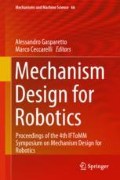Abstract
The recent years have witnessed a paradigm shift from making stiff robots towards making compliant ones. The latter brings several benefits such as enhancing force control in physical interaction scenario of robots with unknown environments, among others. Indeed, collaborative robots, known as cobots, stands as one of the main applications of this new paradigm. Herein, safety aspect is considered by presenting the new Variable Stiffness Safety Oriented Mechanism (V2SOM) [1]. As its name indicates, V2SOM aims at making physical Human Robot Interaction (pHRI) safe, thanks to its two basic functioning modes, i.e. high stiffness mode and low stiffness mode. The first mode for normal operational routines. In contrast, low stiffness mode is suited for safe absorption of any potential blunt shock between a human subject and the cobot in place. The transition between the two modes is continuous to maintain a good control of the V2SOM-based cobot in case of fast collision.
Access this chapter
Tax calculation will be finalised at checkout
Purchases are for personal use only
References
Ayoubi, Y., Laribi, M.A., Arsicault, M., Zeghloul, S., Courreges, F.: Mechanical device with variable compliance for rotary motion transmission. FR/IFBT17CNRCOB (2017)
Tobe, F.: Why Co-Bots Will Be a Huge Innovation and Growth Driver for Robotics Industry. http://spectrum.ieee.org/automaton/robotics/industrial-robots/collaborative-robots-innovation-growth-driver
Grioli, G., et al.: Variable stiffness actuators: the user’s point of view. Int. J. Rob. Res. 34(6), 727–743 (2015)
Jianbin, H., Zongwu, X., Minghe, J., Zainan, J., Hong, L.: Adaptive impedance-controlled manipulator based on collision detection. Chin. J. Aeronaut. 22(1), 105–112 (2009)
Gao, D., Wampler, C.W.: Assessing the danger of robot impact. IEEE Robot. Autom. Mag. 16(4), 71–74 (2009)
Pratt, G.A., Williamson, M.M.: Series elastic actuators. In: IEEE/RSJ International Conference on Intelligent Robots and Systems. ‘Human Robot Interaction and Cooperative Robots, vol. 1, no. 1524, pp. 399–406 (1995)
Mathijssen, G., Cherelle, P., Lefeber, D., Vanderborght, B.: Concept of a series-parallel elastic actuator for a powered transtibial prosthesis. Actuators 2(3), 59–73 (2013)
Zinn, M., Roth, B., Khatib, O., Salisbury, J.K.: A new actuation approach for human friendly robot design. Int. J. Rob. Res. 23(4), 379–398 (2004)
Wolf, S., et al.: Variable stiffness actuators: review on design and components. IEEE/ASME Trans. Mechatron. 4435(c), 2418–2430 (2015)
Petit, F., Friedl, W., Hannes, H., Grebenstein, M.: Antagonistic variable stiffness mechanism. Trans. Mechatron. 20(2), 684–695 (2015)
Ayoubi, Y., Laribi, M.A., Courrèges, F., Zeghloul, S., Arsicault, M.: A complete methodology to design a safety mechanism for prismatic joint implementation. In: IEEE/RSJ International Conference on Intelligent Robots and Systems, pp. 304–309 (2016)
Eiberger, O., Haddadin, S., Weis, M., Albu-Schäffer, A., Hirzinger, G.: On joint design with intrinsic variable compliance: derivation of the DLR QA-joint. In: Proceedings of the IEEE International Conference on Robotics and Automation, pp. 1687–1694 (2010)
Acknowledgments
This work is supported by the French National Research Agency, convention ANR-14-CE27-0016. This work is sponsored by the French government research program Investissements d’avenir through the Robotex Equipment of Excellence (ANR-10-EQPX-44).
Author information
Authors and Affiliations
Corresponding author
Editor information
Editors and Affiliations
Rights and permissions
Copyright information
© 2019 Springer Nature Switzerland AG
About this paper
Cite this paper
Ayoubi, Y., Laribi, M.A., Zeghloul, S., Arsicault, M. (2019). Design of V2SOM: The Safety Mechanism for Cobot’s Rotary Joints. In: Gasparetto, A., Ceccarelli, M. (eds) Mechanism Design for Robotics. MEDER 2018. Mechanisms and Machine Science, vol 66. Springer, Cham. https://doi.org/10.1007/978-3-030-00365-4_18
Download citation
DOI: https://doi.org/10.1007/978-3-030-00365-4_18
Published:
Publisher Name: Springer, Cham
Print ISBN: 978-3-030-00364-7
Online ISBN: 978-3-030-00365-4
eBook Packages: Intelligent Technologies and RoboticsIntelligent Technologies and Robotics (R0)

